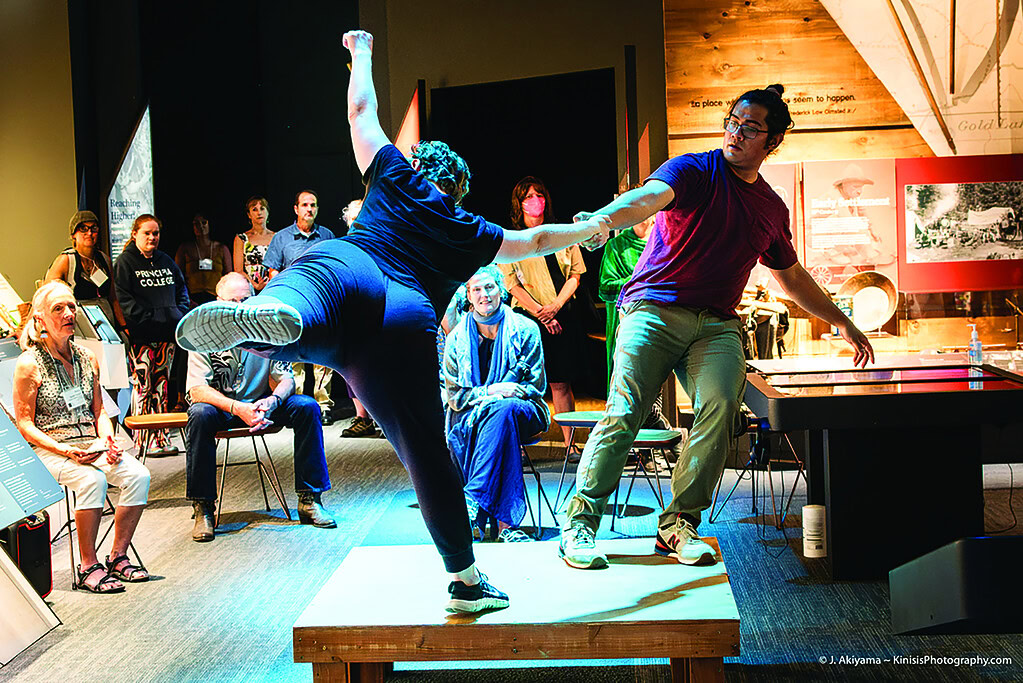
When CU Boulder alum Michelle Bernier attended a campus film screening organized by the Sans Souci Festival of Dance Cinema as a grad student in 2013, she didn’t know it would choreograph the next decade of her life.
“I remember thinking, ‘What is a dance film?’ I’d been a dancer my whole life — it was what I was going to graduate school for — but I’d never heard of this art form,” Bernier recalls. “I checked out a screening and was totally floored. I literally wrote to the festival, saying, ‘I’m here; I want to volunteer.’”
That enthusiasm led her to work closely with then-executive director David Leserman, eventually taking over the role herself in 2016. Now, as Bernier prepares to lead the 21st annual Sans Souci Festival at the Museum of Boulder from Aug. 30 to Sept. 1, she reflects on the event’s evolution and the organization’s 2023 decision to become a nonprofit.
“We are a slowly evolving organization,” she says. “Our mission has always been to show art and whet the audience’s appetite for the work so that more can be created. Being a nonprofit matched our sense of place in the community, which was both a gathering place and a global force in the field of dance cinema. We want Boulder to remain a hub for dance film.”
Unpacking the movement
Michelle Ellsworth and Brandi Mathis founded the festival in 2003 while sitting on the porch of a 1967 Marlette mobile home in Boulder’s Sans Souci manufactured housing community. They both enjoyed choreographing dances for the screen, so they worked with the Boulder Museum of Contemporary Art, CU Boulder’s Department of Theatre & Dance and local artists Ana Baer and Hamel Bloom (Leserman’s stage name) to turn their ideas into a dance film festival.
But as Bernier asked herself a decade ago: What exactly is a dance film? Also known as screendance, this practice is an art form that combines dance and filmmaking to create a visual narrative in which choreography and cinematography play equal roles. Dance films use camera and editing techniques to capture movement in ways that would be impossible in a live setting, while experimenting with space, timing and perspective.
“We are not looking for films that have one or five great dance sequences but are really a narrative film that has nothing to do with dancing,” Bernier says. “We’re also not looking for a recording of a performance. The camera must be a player in the film; it must be a dance that you couldn’t see on a stage.”

Over the years, the festival has screened more than 800 films from around the world and has expanded to international tours in Mexico, Germany and Brazil. Bernier says organizing such a feat is not without its hurdles, particularly when it comes to securing funding for an event many people might not understand.
“Folks do want to come out to an event like this, but ticket prices just don’t support the overhead work of running the festival,” Bernier says. “Also, unlike Boulder Ballet and the Boulder International Film Festival, where people know what to expect right away, when you say ‘dance film’ to someone, they either say, ‘What the heck is that?’ or ‘Oh, yeah, I watch those on TikTok all the time.’ This is not TikTok; that’s not what we’re talking about.”
Bernier says much of her job involves the “delightful challenge” of explaining to people what dance cinema is all about. She says it’s easier now than it was 10 years ago.
“I used to tell people it’s one of Boulder’s best-kept secrets,” Bernie says. “But last year we sold out two out of three of our premiere showings, so word is getting out there.”
‘Accessible to everyone’
As the Sans Souci Festival prepares for its 21st go-round, Bernier is eager to capitalize on the growing momentum. This year’s event includes virtual reality dance films alongside more traditional video installations and live performances.
“We don’t want this to feel like just another film festival where you sit down, watch a screening and leave,” Bernier explains. “We want it to be a complete sensory experience, where you interact with the installations and the performances to fully immerse yourself in the world of dance film.”
This year’s highlights include Innate Stimulate by first-time filmmaker Megan Roney, created as part of Sans Souci Festival’s Community Dance Film Projectand supported by the City of Boulder Arts & Culture. For the virtual reality component, visitors will experience Before We Flew Like Birds, We Flew Like Clouds, a 360-degree video profile of professional speed skater Maurice Hall. The film by KT Niehoff is part of a series of VR installations responding to the question: “What does it feel like to be in your body?”
As Bernier looks toward the future, she hopes the festival will continue to grow and reach new audiences while deepening its roots in Boulder.
“In our culture, we have this idea of epic, disproportionate growth that never ends, which is kind of unhealthy, but I believe that Sans Souci has the potential to reach more people,” Bernier says. “I hope to see Sans Souci evolve into a festival that draws in thousands, not just hundreds. On the artistic side, I would like to see more exploration of the technologies themselves, as well as more VR that pushes the limits of what is possible in dance cinema, while making this art form accessible to everyone.”
ON SCREEN: Sans Souci Festival of Dance Cinema. Aug. 30 through Sept. 1, Museum of Boulder, 2205 Broadway St. $36 per day
